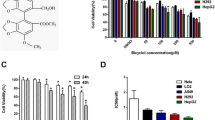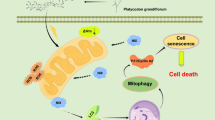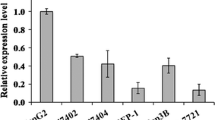Abstract
We previously found that there was up-regulation of APMCF1 expression in apoptotic MCF-7 cells. Moreover, bioinformatics analysis has found that APMCF1 molecules had similar size and structure with molecules which belong to small G-protein superfamily. We presume that APMCF1 plays certain biological role in the regulation of cell proliferation and apoptosis. In this study, we first detected the expression pattern of APMCF1 in human hepatocellular carcinoma cell line and find no expression in Human Hepatocellular carcinoma cells (HHCC) and enhanced expression in HepG2 cells. Expression of liposome-mediated ectogenic APMCF1 induced inhibition of HHCC growth and cell cycle, and RNAi inhibited APMCF1 expression and promoted HepG2 cell growth. Results of cell cycle gene chips analysis showed up-regulation of p21 expression and down-regulation of TIMP3 in HHCC cells expressing ectogenic APMCF1, indicating that APMCF1 participates at least partially in cell cycle regulation through regulating genes such as p21 and TIMP3.



Similar content being viewed by others
Abbreviations
- APMCF1:
-
Apoptosis related of MCF-7 cells
- HHCC:
-
Human Hepatocellular carcinoma cells
- TIMP3:
-
Tissue inhibitor of metalloproteinases 3
- DMEM:
-
Dulbecco’s-modified Eagle medium
- MTT:
-
Methylthiazolyldiphenyl-tetrazolium bromide
References
Adjei AA (2001) Blocking oncogenic Ras signaling for cancer therapy. J Natl Cancer Inst 93(14):1062–1074
Bacher G, Pool M, Dobberstein B (1999) The ribosome regulates the GTPase of the b-subunit of the signal recognition particle receptor. J Cell Biol 146(4):723–730
Baliga BC, Kumar S (2002) Role of Bcl-2 family of proteins in malignancy. Hematol Oncol 20:63–74
Broceno C, Wilkie S, Mittnacht S (2002) RB activation defect in tumor cell lines. Proc Natl Acad Sci USA 99:14200–14205
Chang C, Werb Z (2001) The many faces of metalloproteases: cell growth, invasion, angiogenesis and metastasis. Trends Cell Biol 11(11):s37–s43
Chen G, Goeddel DV (2002) TNF-R1 signaling: a beautiful pathway. Science 296:1634–1635
Cohen O, Kimchi A (2001) DAP-kinase: from functional gene cloning to establishment of its role in apoptosis and cancer. Cell Death Differ 8:6–15
Daigle JL, Hong JH, Chiang CS, McBride WH (2002) The role of tumor necrosis factor signaling pathways in the response of murine brain to irradiation. Cancer Res 61:8859–8865
El-Deiry WS, Tokino T, Veleculescu VE et al (1993) WAF1, A potential mediator of p53 tumor suppression. Cell 75:817–825
Hatoum A, El-Sabban ME, Khoury J, Yuspa SH, Darwiche N (2001) Overexpression of retinoic acid receptors alpha and gamma into neoplastic epidermal cells causes retinoic acid-induced growth arrest and apoptosis. Carcinogenesis 22:1955–1963
Holtzman MJ, Green JM, Jayaraman S, Arch RH (2000) Regulation of T cell apoptosis. Apoptosis 5:459–471
Ikeguchi M, Saito H, Katano K et al (1998) Expression of P53 and P21 are independent prognositic factors in patients with serosal invasion by gastric carcinoma. Digest Dis Sci 43:964–967
Javelaud D, Besancon F (2002) Inactivation of p21WAF1 sensitizes cells to apoptosis via an increase of both p14ARF and p53 levels and an alteration of the Bax/Bcl-2 ratio. J Biol Chem 277:37949–37954
Kamitani H, Taniura S, Watanabe K et al (2002) Histone acetylation may suppress human glioma cell proliferation when p21 WAF/Cipl and gelsolin are induced. Neuro-oncol 4(2):95–101
Kang UA, Kim JT (2003) Anti-angiogenic and anti-tumor invasive activities of tissue inhibitor of metalloproteinase-3 from shark, Scyliorhinus torazame. Biochim Biophys Acta 1620:59–64
Kim JR, Kim CH (2004) Association of a high activity of matrixmetalloproteinase-9 to low levels of tissue inhibitors of metalloproteinase-1 and -3 in human hepatitis B-viral hepatoma cells. Int J Biochem Cell Biol 36:2293–2306
Makin G, Dive C (2001) Apoptosis and cancer chemotherapy. Trends Cell Biol 11(11):S22–26
Miller JD, Tajima S, Lauffer L, Walter P (1995) The β subunit of the signal recognition particle receptor is a transmembrane GTPase that anchors the αsubunit, a peripheral membrane GTPase, to the endoplasmic reticulum membrane. J Cell Biol 128(3):273–282
Neurath MF, Finotto S, Fuss I, Boirivant M, Galle PR, Strober W (2001) Regulation of T-cell apoptosis in inflammatory bowel disease: to die or not to die, that is the mucosal question. Trends Immunol 22:21–26
Nikitin AY, Liu CY, Flesken-Nikitin A, Chen CF, Chen PL, Lee WH (2002) Cell lineage-specific effects associated with multiple deficiencies of tumor susceptibility genes in Msh2(-/-)Rb(+/−) mice. Cancer Res 62:5134–5138
Ohashi K, Nemoto T, Eishi Y et al (1997) Expression of the cyclin dependent kinase inhibitor P21WAF1/CIP1 in human esophageal squamous cell carcinomas. Virchows Arch430:389–395
Rimner A, Wischhusen J, Naumann U et al (2001) Identification by suppression subtractive hybridization of p21 as a radio-inducible gene in human glioma cells. Anticancer Res 21(5):3505–3508
Senger DL, Tudan C, Guiot MC et al (2002) Suppression of rac activity induces apoptosis of human glioma cells but not normal human astrocytes. Cancer Res 62(7):2131–2140
Spurbeck WW, Catherine YC, Vanin EF et al (2002) Enforced expression of tissue inhibitor of matrix metalloproteinase-3 affects functional capillary morphogenesis and inhibits tumor growth in a murine tumor model.Blood 100:3361–3368
Spurbeck WW, Catherine YC, Vanin EF et al (2003) Retroviral vector-producer cell-mediated in vivo gene transfer of TIMP-3 restricts angiogenesis and neuroblastoma growth in mice. Cancer Gene Ther 10:161–167
Stefanaki K, Rontogiannis D, Vamvouka C et al (1998) Immunohistochemical detection of bcl2, P53, mdm2 and P21/waf1 proteins in small-cell lung carcinomas. Anticancer Res 18:1689–1696
Suzuki Y, Honma T, Hayashi S, Ajioka Y, Asakura H (2002) Bcl-2 expression and frequency of apoptosis correlate with morphogenesis of colorectal neoplasia. J Clin Pathol 55:212–216
Urquhart JL, Meech SJ, Marr DG, Shellman YG, Duke RC, Norris DA (2002) Regulation of Fas-mediated apoptosis by N-ras in melanoma. J Invest Dermatol 119:556–561
Vaillant B, Chiaramonte MG, Cheever AW, Soloway PD, Wynn TA (2001) Regulation of hepatic fibrosis and extracellular matrix genes by the th response: new insight into the role of tissue inhibitors of matrix metalloproteinases. J Immunol 167:7017–7026
Waga S, Hannon GJ, Beach D et al (1994) The P21 WAF1 inhibitor of cyclin dependent kinases controls DNA replication by interaction with PCNA. Nature 369:574–578
Yan W, Li Q, Zhu F et al (2001a) Apoptosis related genes cloned by improved subtractive hybridization. Chin J Oncol 23(3):193–195
Yan W, Zhu F, Zhao Z-L, Cai Y-B, Yue W, Shao C, Lu F, Li Q, Wang C-J (2001b) Improved PCR-based subtractive hybridization, a new strategy on cloning differential expression genes in apoptotic MCF-7 cells. J Cell Mol Immunol 179(1):35–37
Yan W, Wang WL, Zhang P, Fei LL (2003) Cloning, expression and preparation of polyclonal antibody of APMCF1, a novel human gene of signal recognition particle receptor. J Fourth Mil Med Univ 24(11):964–967
Yan W, Yue W, Zhu F (2004) Molecular cloning and characterization of full-length apoptosis-related gene APMCF1 and its tissue expression pattern. J Tumor Marker Oncol 19(1):57–67
Yoshiji H, Kuriyama S, Miyamoto Y, Thorgeirsson UP, Gomez DE, Kawata M,Yoshii J, Ikenaka Y, Noguchi R, Tsujinoue H, Nakatani T, Thorgeirsson SS, Fukui H (2000) Tissue inhibitor of metalloproteinases-1 promotes liver fibrosis development in a transgenic mouse model. Hepatology 32:1248–1254
Yu JL, Rak JW, Coomber BL, Hicklin DJ, Kerbel RS (2002) Effect of p53 status on tumor response to antiangiogenic therapy. Science 295:1526–1528
Acknowledgements
We thank Chendan, Wuyousheng for assistance with our experiments. This work was supported by the National Natural Science Foundation of China, No.30270667.
Author information
Authors and Affiliations
Corresponding author
Rights and permissions
About this article
Cite this article
Li, Q., Yan, W., Cheng, S. et al. Introduction of G1 phase arrest in Human Hepatocellular carcinoma cells (HHCC) by APMCF1 gene transfection through the down-regulation of TIMP3 and up-regulation of the CDK inhibitors p21. Mol Biol Rep 33, 257–263 (2006). https://doi.org/10.1007/s11033-006-9007-9
Received:
Accepted:
Published:
Issue Date:
DOI: https://doi.org/10.1007/s11033-006-9007-9




